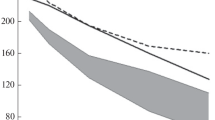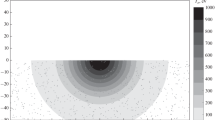Abstract
The consequences of the entry of the magnetic field from underlying layers into the Sun’s chromosphere are studied via numerical solution of the 2D MHD problem (with constant physical quantities along the straight horizontal magnetic lines of force). Chromospheric plasma is considered to be collisional; its Joule dissipation and the Hall effect are taken into account. The initial magnetic field is characterized by a value of β = 1.5 and corresponds to an upward current sheet of finite thickness. There are cases in which the coevolution of the magnetic field and plasma leads to the formation of a very thin, vertical current sheet, from which a plasma stream flows downward vertically. The process turned out to be typical of rather large heights, where the influence of the Hall effect on the magnetic field evolution begins to exceed the field-drift effect due to the (partial) freezing of the force lines. The formed thin current sheet then ceases to exist under the action of pinch (sausage and/or kink) instabilities. The reconnection of force lines is not seen under the conditions of this numerical experiment due to the assumed constancy of physical quantities (including velocity) along a force line. Accordingly, the described processes in nature will act as alternative or additional processes with respect to the typically considered scenarios of reconnection.









Similar content being viewed by others
REFERENCES
Alekseeva, L.M., Physical nature of the anode explosion in plasma channels, Pis’ma Zh. Eksp. Teor. Fiz., 1980, vol. 6, no. 21, pp. 1310–1312.
Alekseeva, L.M., Generation of magnetic field by acceleration of Hall plasma and some consequences of this process, in Proc. XXIII Int. Conf. on Phenomena in Ionized Gases, Toulouse, France, 17–22 July 1997, Toulouse: University of Paul Sabatier, 1997, Bordage, M.C. and Gleizes, A., Eds., vol. 2, pp. 156–157.
Alekseeva, L.M., Effective gravity due to the Hall effect and quasi-acoustic-gravity waves in accelerated plasma flows, J. Plasma Phys., 1999, vol. 61, no. 5, pp. 671–699.
Alekseeva, L.M., The Hall effect as the producer of current sheets in astrophysical plasmas, Astron. Lett., 2006, vol. 32, no. 4, pp. 274–281.
Alekseeva, L.M. and Kshevetskii, S.P., Solar plasma structuring due to two-dimensional pinch effect over the photosphere, Astrophys. Bull., 2011, vol. 66, no. 1, pp. 72–81.
Alekseeva, L.M. and Kshevetskii, S.P., Magnetohydrodynamic evolution of plasma in the contact zone of oppositely directed magnetic fields and “artificial objects” in the solar atmosphere, Izv. Krym. Astrofiz. Obs., 2013, vol. 109, no. 3, pp. 155–164.
Alekseeva, L.M. and Kshevetskii, S.P., Numerical MHD simulation of the coupled evolution of plasma and magnetic field in the solar chromosphere. I. Gradual and impulsive energisation, Sol. Phys., 2015, vol. 290, no. 11, pp. 3295–3318. https://doi.org/10.1007/s11207-015-0788-7
Aschwanden, M.J., Physics of the Solar Corona: An Introduction, Berlin: Springer, 2004.
Balescu, R., Transport Processes in Plasmas, vol. 1, Amsterdam: Elsevier, 1988.
Braginskii, S.I., The phenomenon of transport in plasma, in Voprosy teorii plazmy (Problems of Plasma Theory), Leontovich, M.A., Ed., Moscow: Atomizdat, 1963, vol. 1, pp. 188–272.
Brushlinskii, K.V. and Morozov, A.I., Calculation of two-dimensional plasma channel flows, in Voprosy teorii plazmy (Problems of Plasma Theory), Leontovich, M.A., Ed., Moscow: Atomizdat, 1974, vol. 8, pp. 88–163.
Brushlinskii, K.V. and Ratnikova, T.A., Numerical model of the near-electrode-layer instability in plasma accelerator channels, Plasma Phys. Rep., 1995, vol. 21, no. 9, pp. 743–748.
Brushlinskii, K.V. and Ratnikova, T.A., Hall corrections into calculations of a plasma flows in the electrode sheaths of coaxial channels, Plasma Phys. Rep., 1997, vol. 23, no. 2, pp. 110–114.
Demoulin, P. and Klein, K.-L., Structuring of the solar plasma by the magnetic field, in Transport and Energy Conversion in the Heliosphere. Lecture Notes in Physics, 2000, vol. 553, Rozelot, J.P., Klein, L., and Vial, J.-C., Eds., Berlin: Springer, 2000, pp. 1–99.
Gabriel, A.H., Some problems in understanding the solar corona, in IAU Colloquium 144: Solar Coronal Structures, Rusin, V., Heinzel, P., and Vial, J.-C., Eds., Tatranska Lomnica: Slovak Academy of Sciences, 1994, pp. 1–9.
Gavrilov, N.M. and Kshevetskii, S.P., Three-dimensional numerical simulation of nonlinear acoustic–gravity wave propagation from the troposphere to the thermosphere, Earth Planets Space, 2014, vol. 66, no. 1, id 88.
Gavrilov, N.M., Kshevetskii, S.P., and Koval, A.V., Verifications of the high-resolution numerical model and polarization relations of atmospheric acoustic–gravity waves, Geosci. Model Dev., 2015, vol. 8, no. 6, pp. 1831–1838.
Goodman, M.L., Self-consistent magnetohydrodynamic modeling of current sheet structure and heating using realistic descriptions of transport processes, Astrophys. J., 2005, vol. 632, pp. 1168–1175.
Kshevetskii, S.P., Study of vortex breakdown in a stratified fluid, Comput. Math. Math. Phys., 2006, vol. 46, no. 11, pp. 1988–2005.
Kshevetskii, S.P., Mathematical program for simulating the evolution of fully ionized plasma PLASMAT, Certificate of state registration no. 2 013 618 823, 2013.
Kshevetskii, S.P. and Gavrilov, N.M., Vertical propagation, breaking and effects of nonlinear gravity waves in the atmosphere, J. Atmos. Sol.-Terr. Phys., 2005, vol. 67, pp. 1014–1030.
Leake, J.E., Lukin, V.S., and Linton, M.G., Magnetic reconnection in a weakly ionized plasma, Phys. Plasmas, 2013, vol. 20, no. 6, id 061202.
LeVeque, R.J., Numerical Methods for Conservation Laws, Basel: Birkhäuser, 1992.
Morozov, A.I. and Solov’ev, L.S., Stationary plasma flows in the magnetic field, in Voprosy teorii plazmy (Problems of Plasma Theory), Leontovich, M.A., Ed., Moscow: Atomizdat, 1974, vol. 8, pp. 3–87.
Ni, L., Lukin, V.S., Murphy, N.A., and Lin, J., Magnetic reconnection in strongly magnetized regions of the low solar chromosphere, Astrophys. J., 2018, vol. 852, no. 2, id 95.
Priest, E.R., Solar Magnetohydrodynamics, Dordrecht: Springer, 1982; Moscow: Mir, 1985.
Priest, E., Magnetohydrodynamics of the Sun, Cambridge: Cambridge University Press, 2014.
Priest E. and Forbs, T., Magnetic Reconnection : MHD Theory and Applications, New York: Cambridge University Press, 2000; Moscow: Fizmatlit, 2005.
Schrijver, C.J., The coronae of the Sun and solar-type stars (CD-ROM Directory: contribs/schrijv), in 11th Cambridge Workshop on Cool Stars, Stellar Systems and the Sun, ASP Conference Proceedings, Garcia Lopez, R.J., Rebolo, R., and Zapaterio Osorio, M.R., Eds., San Francisco: Astronomical Society of the Pacific, 2001, vol. 223, pp. 131–144.
Spitzer, L., Physics of Fully Ionized Gases, New York: Interscience, 1962; Moscow: Mir, 1965.
Syrovatskii, S.I., Magnetic hydrodynamics, Usp. Fiz. Nauk, 1957, vol. 62, pp. 247–303.
Syrovatskii, S.I., Formation of current sheets in a plasma with a frozen-in strong magnetic field, Sov. Phys. JETP, 1971, vol. 33, no. 5, pp. 1727–1741.
Thomas, J.P. and Roe, P.L., Development of non-dissipative numerical schemes for computational aeroacoustics, in AIAA 11th Computational Fluid Dynamics Conference, Technical Papers 2, Orlando, Fla.: AIAA, 1993, pp. 906–916.
Voevodin, Vl.V., Zhumatii, S.A., Sobolev, S.I., Antonov, A.S., Bryzgalov, P.A., Nikitenko, D.A., Stefanov, K.S., Voevodin, Vad.V., The practice of the Lomonosov supercomputer, Otkrytye Sist., 2012, no. 7, pp. 36–39.
Zelenyi, L.M., Malova, H.V., Grigorenko, E.E., and Popov, V.Yu., Thin current sheets: from the work of Ginzburg and Syrovatskii to the present day, Phys.-Usp., 2016, vol. 186, no. 11, pp. 1057–1090.
ACKNOWLEDGMENTS
The authors are grateful to A.V. Getling for constant attention to this work, the discussion of its results, and valuable advice.
This work was performed on the equipment of the Moscow State University Supercomputing Center for Collective Use for high-performance computer resources.
Funding
This work was supported by the Russian Foundation for Basic Research, project no. 17-05-00574 (the used numerical method and software code are a development of the method and software created for the simulation of atmospheric processes, and they include additional blocks for the calculation of electrodynamical fields and currents).
Author information
Authors and Affiliations
Corresponding authors
Additional information
Translated by M. Samokhina
APPENDIX
APPENDIX
The known classical formulas are used for the material parameters of the plasma. The plasma conductivity (Spitzer, 1965; Balescu, 1988)
(where \({{\tau }_{e}}\) is the time between the electron–ion collisions) enters into the magnetic viscosity
which, with allowance for (3), takes the form \({\Theta }\) in (9), where
Similarly, the thermal conductivity (Aschwanden, 2004) takes the form \(K\) in (9),
where \({{k}_{S}}\) is the thermal conductivity by Spitzer and \({\Lambda }\) is the Coulomb logarithm.
We give also several formulas that were not used in this work but may be helpful in a comparison of its content with the works of other authors. The dimensionless electric field (Brushlinskii and Morozov, 1974), which corresponds to the MHD system (4)–(7), is expressed by the values used in this system
for the field transformation to the dimensional form, the combination \({{B}_{0}}{{{{{v}}_{{*0}}}} \mathord{\left/ {\vphantom {{{{{v}}_{{*0}}}} c}} \right. \kern-0em} c}\) serves as a unit. Expression (A4) sometimes is convenient to use in the identical form (Alekseeva, 1980)
where
denotes the effective electric field, while \({{\sigma }_{P}}\) and  are local (and nondimensionalized) values of the Pedersen and Hall conductivities:
are local (and nondimensionalized) values of the Pedersen and Hall conductivities:
It is also worth noting that parameter \(\xi ,\) as defined by Eq. (8), characterizes the difference in the dimensionless macroscopic velocities of the ion and electron gases
and enters the important relation
where \({{\omega }_{e}}\) is the frequency of Larmor gyration of an electron (see §§ 1.2 and 2.5 in (Brushlinskii and Morozov, 1974)).
Rights and permissions
About this article
Cite this article
Alekseeva, L.M., Kshevetskii, S.P. Numerical Simulation of Vertical Current Sheets in Solar Chromospheric Plasma with the Hall Effect. Geomagn. Aeron. 59, 509–523 (2019). https://doi.org/10.1134/S0016793219040030
Received:
Revised:
Accepted:
Published:
Issue Date:
DOI: https://doi.org/10.1134/S0016793219040030




